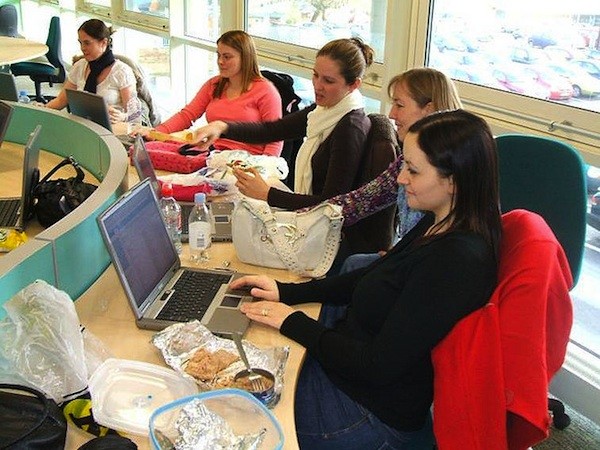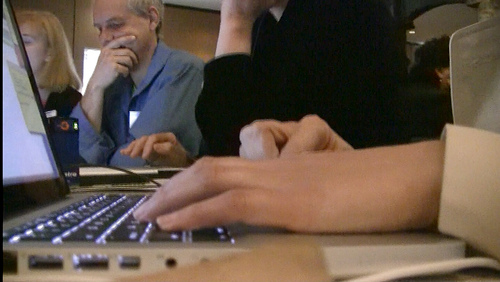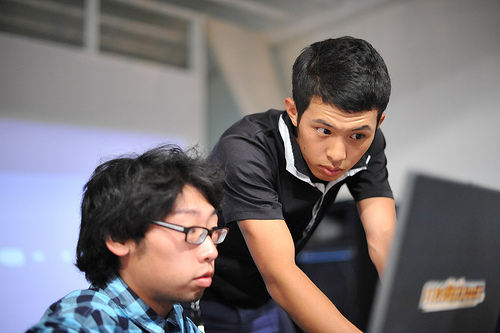Learning Reimagined: Participatory, Peer, Global, Online

This is a golden age for motivated self-learners, given the availability of open educational resources - from MIT's OpenCourseWare, Wikipedia, Wikiversity, and YouTube EDU to the Khan Academy and Apple's iTunes U, together with every possible online communication tool a learner could want - audio, video, forums, blogs, wikis, chat rooms, whiteboards, social bookmarking, mindmapping, and curation services, all free of charge or inexpensive. A population interested in online learning, a mountain of content, and a cornucopia of communication media are almost sufficient for explosive growth of networked, collaborative learning, but require one additional key ingredient: know-how.
After a thousand years of experience in traditional physical classrooms with print media and lectures, we've only had a few years of widespread experimentation with online social media and digital texts for learning.
Given the availability of open educational resources and free Web media, what does a group of people need to know about pedagogy in order to self-organize into a peer learning community?
Tools are only the beginning. Attitudes and methods are essential, too. I want to share my experiences in attempting to facilitate collaborative learning communities online.
When I orient co-learners in the first live session of Introduction to Mind Amplifiers, the five week online mini-course I created as the first offering in my "pop-up university" experiment, Rheingold U, I start by emphasizing our first task and continuing objective: coalescing into a learning community. Only after we discuss what it means to be a learning community do I introduce the tools and texts in the context of that objective. I've run the course four times now, with approximately 30 co-learners each time. At the end of our five weeks, co-learners reflect about the course in an hour-long live audio-video-chat session, in a week-long online asynchronous forum, and in an anonymous survey. The feedback continually drives changes in my methods. Sometimes changes occur mid-stream when co-learners brainstorm a new assignment or provoke me to come up with a new way to run a live session. Although I'm still at the beginning of the learning process, I'm hoping to contribute to a collective, ongoing, evolution of online peer learning communities by sharing some of my discoveries.
Big Lessons Learned
First, I have found that in both my traditional physical classrooms and online environments, the chances of successful outcomes are multiplied when every person in the group makes a commitment to active participation in helping others learn.
I never call the people who sign up for the courses I offer online "students." We are all "co-learners." The terminology both acknowledges and inspires the kind of collaborative learning that turns a reading group into something much more exciting. In both formal, face-to-face, educational institutions and experimental online groups, I work from the first moments to persuade people that it's possible for all of us to learn together as a community in a more deeply satisfying and useful way than if students take responsibility only for their own learning. It doesn't take much persuasion - when everybody pitches in at the start, enthusiasm spontaneously combusts. When a sufficient number of people jump in and start contributing and building on one another's contributions, it becomes clear to all that it's not just about the teacher's performance and the student's ability to complete assignments. It's about our joint effort to make the whole of our encounter more valuable than just the sum of our individual learning.
The success of the situations I'm describing depends on the efforts of a core group of enthusiastic self-learners - or at least a majority of the group who are willing to try an alternative to the kind of schooling they are accustomed to. I'm not sure this method would work with lesser motivated students. 
#mindamp
By the fourth time I led a cohort of co-learners through the course we've come to call "#mindamp," I had stumbled onto a way to provoke co-learning right from the start. I've been using Blackboard Collaborate (formerly known as Elluminate) for live sessions because it allows up to six to stream video at once, enables any one of up to fifty participants (on my license) to take over the microphone, makes it possible for me to push slides (and save slidesets), lead collaborative whiteboarding, lead Web tours, share my desktop and applications. In the first session I use all of those affordances to show co-learners how our forum and blog software works and to preview the content we'll explore over the next five weeks.
I take a minute at the beginning of a live session to explain how the communication environment works, from text chat to video. Then I use an exercise I learned from Steve Hargadon's masterful facilitation of Classroom 2.0 live sessions: I put a world map up on the whiteboard and ask participants to put a dot on their location and to type into the chat window their location, the time of day and the weather. Suddenly, everyone is involved, and the map becomes an interesting instant reflection in itself, with co-learners on most continents. My second slide is about the twin goals of learning more about the subject of the course and about cultivating a community of co-learners. I emphasize that even more primary than our shared goal of learning about infotention, curation, personal learning networks, and cooperation theory is our goal of becoming a learning community. One of the co-learners asked me if this meant "the Socratic method," and I replied: "Yes, if we are all Socrates and we don't ask questions to lead others to a canon of established knowledge, but ask questions to enlarge and refine our understanding."
The third slide is a blank writeable whiteboard screen. I ask the co-learners to self-organize into teams to help make sense of the information that will be flowing through multiple channels during the live session. I type roles on the whiteboard and show how to use the whiteboard tools to enter, format and move around elements. Roles include searchers, chat summarizers, session summarizers, mindmap leaders, session bloggers. I ask co-learners to write their own names on the whiteboard next to the roles they want to take, show them how to create break-out rooms to coordinate their collaborations, and ask the summarizers to feed their output to the bloggers, who take responsibility for posting a reflective summary of the session later in our asynchronous learning environment, the Social Media Classroom (SMC).
The Magic of Co-Learnerhood
In that first live session, the first magic begins to manifest as we all watch names appear on the whiteboard and the entire group of 10-20 co-learners self-organizes into teams in a matter of a few minutes. The only instruction I give is on how to self-organize. After we've divided up the roles, I talk about all the tools we will use over the next five weeks in terms of learning goals and methods. Knowing why we use forums, blogs, wikis, synchronous chat and video, social bookmarks, mindmaps is the foundation for the kind of active inquiry, culture of conversation, self-directed collaborative groups that bring a peer learning group to life. Slides with evocative illustrations and few words frame my audio-video lecture. At the same time that I push slides to the whiteboard and lecture via video, text-chats scroll up the simultaneous chat window. People can "raise their hand," which rings a chime and flashes an icon for the moderator's attention (and the entire group can have moderator privileges). I stop and hand the microphone over to co-learners who have comments or questions. Sometimes I see a text question in the chat and respond by speaking aloud. When anyone mentions a relevant term, tool, website, person, the search team puts a URL into the chat, the chat summarizers list the URLs with brief descriptions, and in their breakout rooms, the session summarizers and blog team confer, the mindmappers agree on top-level and second-level branching categories. We've been at it for ten minutes and we're already a collective intelligence. It's confusing at first, but it is also flowing.
Yes, we're a collective intelligence, which is exhilarating, but we're a toddler collective intelligence, stumbling around learning to walk and trying to figure out where we're going at the same time. A number of new skills are required in short order. Information and communication flow through multiple simultaneous channels. The enterprise is challenging - that's part of the exercise. Taking my direction from George Siemens' ideas about networked learning ("we emphasize that early course experiences tend to be overwhelming and chaotic") I assure co-learners early and often that we can relax, accept and even embrace the chaos, and regard our networked attempts to make sense of it as the scaffold for our co-learning.
Why not? Instead of seeking to put every fact in its place in an existing well-ordered taxonomy, why not seek to learn together by asking questions about what puzzles us, then organizing our discussions and mining them for knowledge? The summaries and mindmaps posted by co-learners the next day were stunning. I emphasize that these summaries and mindmaps should not be viewed as compositions, but as learning instruments. We take turns taking notes for each other. In both the note-taking and the note-reading, we re-encounter the subject of our inquiry, which we can further refine, analyze, interrogate in group discussions in the forum or individual reflections in the blog.
At the end of my audio-video-slideshow-webtour, I put up another blank whiteboard screen and the mindmapping team puts up the top-level categories they pulled out of the session. Others enter second and third levels, rearrange them, draw connections, style and format the text, add clip-art and place images they have found elsewhere. The magic in this simple whiteboard exercise is that multiple actions can take place simultaneously and nobody knows who is doing what. Words appear, are formatted, moved around, put on blue oval or red square backgrounds, connected with thin or thick lines - and the mapper behind the scenes is not an individual but the group. I've recorded these sessions - scrub to the end of the hour to see the mindmapping come to life during the first live session of a course. From the rough-sketched group mindmap we made during the live session, one of the co-learners made a more rigorously organized version. 
Recommended Tools and Techniques
Blackboard Collaborate has a large toolkit. I'm always experimenting with new features. Sometimes, I get into predicaments and don't know how to quit a webtour or place people in breakout rooms. So I calmly start exploring possible solutions, talking about it as I try to recover. While doing so, I also talk about the importance of exploring close enough to the edge to fall over it frequently. I model tolerance for error, learning from error, pushing the envelope of tech. Indeed, I've found that the earlier I can break something and fix it in public, the better. We talk about what works and what doesn't, discard what doesn't suit our purposes, push a tool further if it helps us learn together. It requires regular doses of humility to abandon what seemed like a bright idea at the time.
The Social Media Classroom is a browser-based environment for discussion, reflection, inquiry, collaboration. It's where discussion takes place between live sessions. Together, we use the live and asynchronous engagements to weave a fabric of discussion.
The forums are about group voice - ongoing conversations in which each co-learner's contributions should build upon, reflect, challenge previous contributions. The objective is a culture of conversation that troubleshoots practical skills, explores theoretical underpinnings, dissects social implications. Forums group together multiple simultaneous asynchronous discussions. Posts can contain in-line graphics, formatted text, hyperlinks, and embedded video, audio, slide players. I refer my co-learners to this excellent piece on shaping a culture of conversation. I scaffold the early discussions by creating discussion threads and provoking discussion, posing questions. As co-learners get the hang of forum discussion, they begin to start their own discussion threads.
The blogs are about individual voice. In the forum, the locus of discussion is the subject matter, but in the blog the locus of discussion is the individual's reflections. All co-learners can participate in the forums and can comment on each other's blog posts, but blog-threads follow the distinctively individual voice of the blogger. Those who want to delve into the rhetoric of blogging can follow exercises and how-tos I've developed around filter-blogging, connective writing, critical-analytic blogging, and advocacy.
Mindmaps are ways to visualize and revisualize the networks and landscapes of ideas, terms, skills we are exploring, a lens for lateral thinking about the issues we approach in a more linear manner in other forums. Individuals can make mindmaps and so can teams. We brainstorm rough mindmaps in live sessions - where nobody can see who is contributing which element - and volunteer teams turn our rough brainstorms into more neatly ordered mindmaps.
Our internal social bookmarks enable us to create a mini-collective-intelligence by gathering resources about our discussion topics, selecting or writing descriptive snippets, assigning tags. The emerging tag-cloud serves as an index to the resources.
Wiki-work is about collaborative authoring. We create lexicons - volunteer teams add words from texts and live sessions to wiki pages and others pitch in by defining, formatting, reorganizing. Sometimes, the most enthusiastic cybrarians mine our forums and blogs and social bookmarks for resources and explanatory context, then copy to emergent categories in the knowledge repository.
Experiment, Experiment, Experiment
In the process of using these tools to try to make sense together, we co-construct our learning. The last week of the course is about re-examining our learning process, reiterating the most important things we've learned, and redesigning the parts of the process that didn't work so well.
Over the past six months, a sufficient number of people have participated in Rheingold U courses for an alumni community to form. The portion of co-learners who are the most enthusiastic about co-learning are using the same media to teach each other, self-organizing knowledge-sharing sessions about agreed topics, with a volunteer facilitator each time.
Our next experiment will be 'paragogy' - can co-learners who have been through this process organize a course without any permanent pedagogical hierarchy?
Banner image credit: jisc_infonet http://www.flickr.com/photos/jiscinfonet/382720207/
Secondary image credit: education.au http://www.flickr.com/photos/educationau/3925401396/
Tertiary image credit: nari344 http://www.flickr.com/photos/nari344/3858828460/
To get more details from Howard, please see his contact info on our Featured Bloggers page.